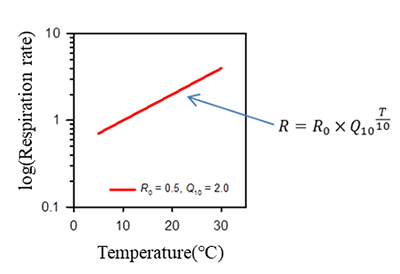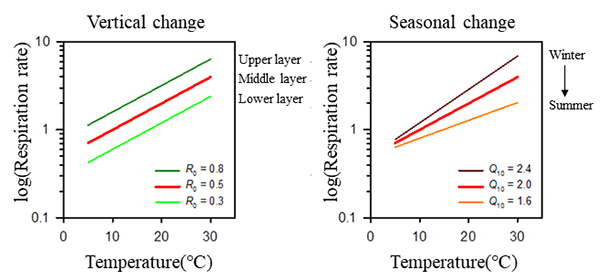Home > Research > Research Results > Research Results 2017 > Considering variations in leaf respiration is important for estimation of annual canopy respiration
Update:August 24, 2017
Main content starts here.
Considering variations in leaf respiration is important for estimation of annual canopy respiration
| Article title |
Vertical and seasonal variations in temperature responses of leaf respiration in a Chamaecyparis obtusa canopy |
|---|---|
| Author (affiliation) |
Masatake Araki (a&b), Koichiro Gyokusen (a), Takuya Kajimoto (b) (a) Kyushu University, Fukuoka, Japan (b) Department of Plant Ecology, FFPRI, Tsukuba, Ibaraki, Japan |
| Publication Journal |
Tree Physiology, 37(10): 1269-1284, February 2017, DOI: 10.1093/treephys/tpx012( External link ) |
| Content introduction |
Plants absorb carbon dioxide from the atmosphere through photosynthesis and release it through respiration. Therefore, understanding the mechanism of plant respiration is important for elucidating the carbon sequestration function of forests and its future prediction. The plant respiration rate is sensitive to short-term changes in temperature, and generally, it doubles when temperature increases by 10℃. Accordingly, it is expected that plant respiration will considerably increase in response to global warming. In this research, we studied vertical and seasonal variations in the leaf respiration rate in a 10-year-old Hinoki cypress (Chamaecyparis obtusa) plantation. The leaf respiration rate was higher in the upper part of the crown than in the lower part, indicating that this vertical variation should be considered for accurately estimating canopy respiration (i.e., total leaf respiration in a plantation). Conventionally,it is assumed that the temperature sensitivity of leaf respiration observed in response to short-term changes in temperature is constant throughout seasons.The seasonal course in the leaf respiration rate estimated using the constant temperature sensitivity directly reflects a seasonal change in air temperature. However, we found that the temperature sensitivity varied seasonally and was high in winter and low in summer. Consequently, the seasonally variable temperature sensitivity resulted in the relatively flat seasonal pattern of leaf respiration even in hot summer compared with the pattern estimated using the constant temperature sensitivity. These results indicated that incorporating vertical and seasonal variations in leaf respiration into carbon cycle models, which often assume the constant temperature sensitivity, might improve not only current estimations but also future predictions of annual total canopy respiration. This research may contribute to the future prediction of forest carbon sequestration function in response to global warming.
The temperature (T)–response curve of the leaf respiration rate (R) has been assumed to be constant
In this study, we demonstrated that the temperature–response curve of the leaf respiration rate varies depending on canopy height and season. Vertically, the slope (=temperature sensitivity, Q10) was constant and the intercept (R0) changed. Seasonally, the intercept was almost constant and the slope changed throughout the season.
Figure. Schematic diagram of vertical and seasonal changes in the temperature–response curve of the leaf respiration rate. |
Copyright © Forest Research and Management Organization. All rights reserved.


